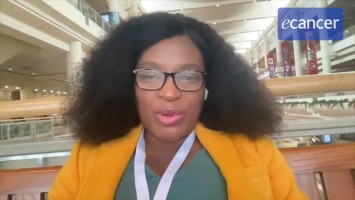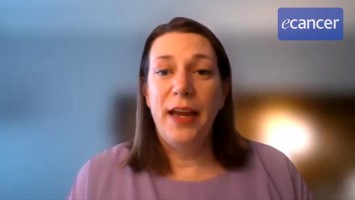I presented a study on the real-world outcomes of brexucabtagene autoleucel, also known as brexu-cel, for relapsed and refractory mantle cell lymphoma. We did a CIBMTR subgroup analysis by prior treatment.
The study was about our real-world outcomes with the CAR T called brexu-cel. It was approved based on the ZUMA-2 trial for patients with mantle cell lymphoma who had prior BTK exposure. In the real world we have patients who have had no prior BTK exposure as well as other broader populations so we wanted to see if these results were comparable to the ZUMA-2 trial. We also wanted to look at subgroups, for example patients that had prior BTK exposure versus those that didn’t, patients that had prior bendamustine exposure versus those that didn’t, patients with prior transplant versus those that did not have a prior transplant, autologous stem cell transplant, and also to look at patients who had brexu-cel earlier, after one or two lines of therapies rather than three or later. So we compared these groups.
The study was conducted, it was a prospective, non-interventional cohort study of brexu-cel using patient data from the CIBMTR. The goal was 500 patients, accruing 500 patients, there were some patients that were then excluded because they had prior non-transplant cellular therapy or the data was not yet ready for analysis. Finally, we had 380 patients that were included in our analysis and there was a median of 12 months follow-up which, again, I want you to note, this is a preliminary, a first look, at the data and a shorter follow-up, relatively speaking. We wanted to look at effectiveness outcomes and key safety outcomes as well.
What was the study design?
This was a prospective non-interventional cohort study of patient data using the CIBMTR database which is a large US national database. So we just looked at outcomes of patients that were getting brexu-cel for mantle cell lymphoma throughout the years from July 2020 to December 2022. There were 84 centres that participated in contributing data towards the CIBMTR database and we had a total of 500 patients that enrolled. Out of them, patients that had a prior history of non-transplant cellular therapy or those where the data was not yet ready for evaluation were excluded, leaving us with a final 380 patients for analysis.
What were the results?
First, the baseline patient characteristics – they were patients that were older compared to the ZUMA-2 data that were also included in the real-world data. We had a broader population of patients with extranodal CNS involvement, patients with four lines of therapy on median, but anywhere from one to twelve, and patients with high-risk characteristics such as those with a high Ki67, ECOG performance status of two or more that were also represented here in this particular cohort.
Then we looked at different subgroups so we looked at the patient characteristics based on the subgroups that I described – BTK exposure or not, bendamustine exposure or not, transplant, as well as lines of therapy, 1-2 lines of therapy versus three or more. The key things here were that older patients were more likely to have had prior bendamustine and less likely to have had prior transplant. When we looked at the patients with no prior BTK therapy they tended to receive brexu-cel earlier, a median of two lines less of therapy, and they were less likely to receive bridging therapy.
Then we looked at the efficacy data. The response rates were similar to the ZUMA-2 data at 90% overall response rates, 78% CR rates. When you look at all the subgroups this was comparable in all subgroups. In fact, those with 1-2 prior lines of therapy had a higher CR rate compared to those with three or more lines of therapy which was a significant improvement.
The 12-month overall survival was 74% and the 12-month PFS was 61%. This is, again, comparable to the ZUMA-2 primary analysis where the 12-month PFS and OS were 61% and 83% respectively. We again looked at the subgroups to see if any particular subgroup had a survival or response advantage. We found that, as I mentioned before, patients who had 1-2 prior lines of therapy had a higher CR rate compared with those that had more lines of therapy which means earlier use seems to have better responses as compared to those that get brexu-cel later on in their disease course. Another interesting finding is that patients who had prior transplant tended to have improved PFS and a reduced risk of relapse which may again speak to the chemosensitivity of the disease for such patients.
Lastly, we also have our safety data, CRS and ICANS being the hallmark toxicity of CAR T. So the CRS rates were 88% with 10% grade 3 or higher CRS. ICANS, which is neurotoxicity, was 60% and 28% of those were high grade CRS. Again, comparing to the ZUMA-2 primary analysis this is similar and there were no new safety concerns. When we have outcomes of interest, I’ll describe those. Those were prolonged cytopenia, cytopenias beyond day 30, there were 21% of patients who had grade 3 or higher thrombocytopenia, 6% of patients who had ANC less than 500 at day 30. Infections, 41% of patients had clinically significant infections which included bacterial, viral and fungal infections. 6% of patients had subsequent neoplasms and the majority of those neoplasms were cutaneous neoplasms. As far as causes of death, the most common cause of death for this cohort was disease relapse and the second most common cause of death was infections.
When we look at safety analysis by subgroup we see some interesting findings such as prior bendamustine was associated with a reduced risk of grade 3 or more ICANS and an increased risk of prolonged thrombocytopenia. Having 1-2 prior lines of therapy as opposed to three and above, those that had 1-2 prior lines of therapy had an increased risk of higher-grade CRS.
So these are interesting findings and all of these may have to do with T-cell fitness and, of course, prior bendamustine exposure may have some marrow suppression.
How do you think this treatment can impact R/R MCL patients?
First of all, these results in the real world confirm, or they continue to prove, the effectiveness and safety of brexu-cel in relapsed and refractory mantle cell lymphoma. Secondly, we see that the complete response rates are higher in those that have had earlier brexu-cel as opposed to later. While our dataset did not show that this translated into an overall survival or PFS difference, which is probably because we’ve had a short follow-up and I’m going to be interested to see what it looks like with a longer follow-up, but this suggests that earlier use may be more beneficial for patients.








